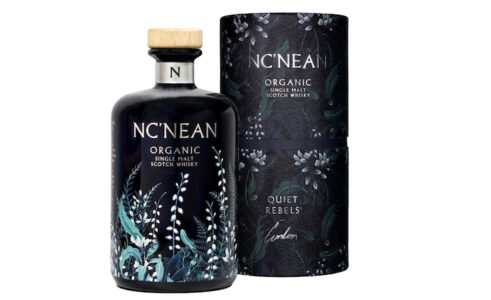American single malt whiskey, as emerging whiskey categories goes, is increasingly finding a footing in different parts of the country, particularly in the Pacific Northwest. Established brands such as Westland, Westward, McCarthy’s and Copperworks, among others, call this region home, making use of the plentiful barley grown there to produce a range of whiskey expressions.
Enter into this American single malt environment Bird Creek Whiskey. A tiny operation in consideration to the others just mentioned, what may give Bird Creek a leg up out the door is its focus on showcasing single barley varietals as individual bottlings. It takes a special knowledge to have this kind of granular focus, which is perhaps why the person behind this, Portland Coffee Roasters founder Mark Stell, is well suited to to it.
Stell, taking his years and years of knowledge of sourcing specialized coffee beans directly from farmers all over the world, is now putting that agricultural knowhow into tracking down rarer single barley types to distill whiskey out of. He’s going for a very boutique experience in the final product he produces, showcasing his wares out of an upscale tasting room adjacent to his barrel aging space. Both share a building with the main cafe for Portland Coffee Roasters in Portland, Oregon.
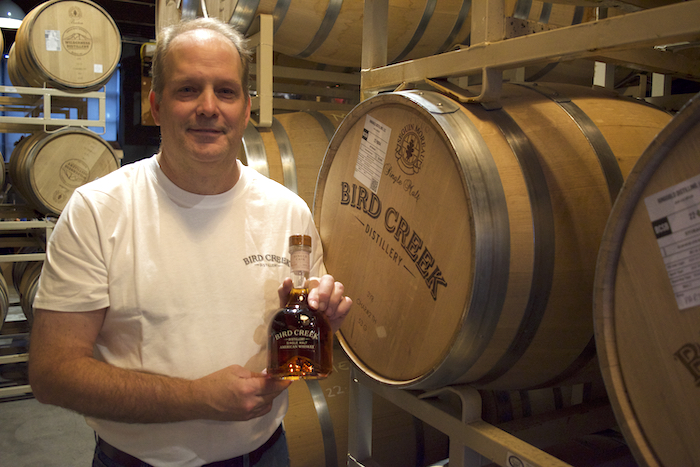
To learn more on his approach to crafting American single malt whiskey, we sat down with Stell recently to get details about his new operation. Note this interview has been edited for clarity and brevity.
The Whiskey Wash (TWW): We are here at a new distillery tasting room in Portland, Oregon called Bird Creek Whiskey, and the focus is American single malt whiskey. We’re sitting with Mark Stell, Bird Creek founder. Mark, tell us a little bit first about your background.
Mark Stell: I’ve been in coffee for 30 years. I’ve had a couple companies, but the last 27 years I’ve founded and have been running Portland Coffee Roasters. I’ve been really, really enjoying the agricultural side of coffee for the last almost 17 years now. That’s kind of where I started to think about doing something a little different and ancillary to this business, where I started really liking certain types of whiskeys and thought I could put my 30 years of research and development in coffee to work in barley products specifically.
About 10 years ago, I kind of got serious about it and started really thinking, “What do I want to do and what do I don’t want to do?” I reached out to a few distilleries and got some advice. The best advice I think I got was do one thing, do one thing well, when you’ve done well at that, look at other things, meaning if you want to do whiskey, do whiskey, don’t do 10 things. If you don’t want to open up a distillery, have somebody else help you with it and then work on your brand and product exclusively.
And so that’s what we started with. We started with talking to some of the distilleries, asking them questions like, “If you wanted to make a single malt from a rare variety, how would you go about doing that?” In coffee, I’ve done this for 30 years, I’ve gone to the farmers direct, whether it’s in Papa New Guinea, Tanzania, South America, found farmers with really, really high end coffees and purchased them, imported them, and then roasted them and got them to market.
But whiskey’s different.
I wanted something local, but yet rare, and that was my focal point, was to try to find my niche. I think that the market in whiskey right now is where coffee was 30 years ago, which means you really don’t know who the farmers are that are producing the products that are being distilled. I feel like that’s a real opportunity for somebody like me who’s been developing that market for the coffee industry – to work with really good farmers who grow great products and they have some sustainable benefits to it, which means they’re either heirloom varietals or a rare variety that we think might make a good whiskey.
And so that’s where we started and what we’ve started with is tackling a few varieties at a time.
TWW: Let’s talk a little bit about the name Bird Creek. How did that come to be your distillery?
Stell: I have a place up in Trout Lake, Washington. I’ve been in Portland for 30 plus years, [but also] have a vacation home up there. Every weekend I’m out fishing, climbing, you name it, outdoors. And really the long term thought about doing a project is to create a brand that taught people about some form of a journey or a adventure along the way.
One of my favorite hikes to do of all time is Bird Creek Meadows Hike on Mount Adams. It’s a rare hike because it’s only opened once a year now because of the fire about seven, eight years ago. You walk up there, there’s amazing flowers and there’s waterfalls and if you want to fish, there’s great fishing.
We were looking for names and I thought, “Well, why don’t we try to find a name associated with Mount Adams,” because eventually we’d like to do our barrel storage and bottling up there.
The concept was really to try to market the Pacific Northwest. What I love about it here is the outdoors and exploring, and our whole theme is that. In the bottle, you’ll see Mount Adams, in the bottom it’s forged in it. The top of the cap is a functioning compass. And each of the caps have one of six different designs that represent things from the Northwest like animals and climbing or exploration.
Our idea is that as we go through this exploration of varietals, we feel like we can take the consumer along with us, whether it’s single barrel releases or blended barrel releases of multiple varieties. As the whiskeys become mature enough to bottle, that’s where I think the fun part will be is coming back and trying something new and different for the customers, not just having one type and having a signature whiskey, but really that exploration of where we think there may be a change in single malts.
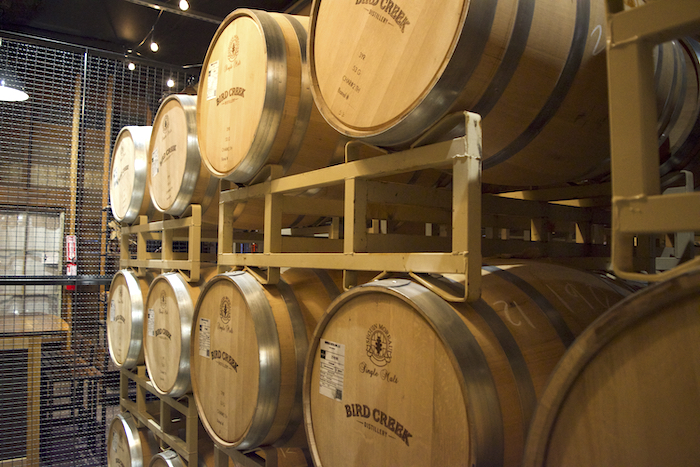
TWW: You’ve chosen to exclusively focus on American single malt. It is definitely an emerging category. You’ve seen a lot of movement in the industry of late, as folks wait for the TTB regulations to finalize on that category, but it’s still also a very niche category in that people still require a lot of education on it. Why did you choose American single malt and what’s your goal in the category?
Stell: I chose single malts because I like single malts. When we first started doing our research, we did the tours all over the world to probably a hundred different distilleries in about three years. I like the flavor profile of barley in our whiskey. I think it’s excellent.
What I really liked about the opportunity with American single malt was that it was a niche, not such a saturated market like bourbon is. And specifically my background in coffee lends to this. It’s like I’ve been grooming for 30 years for this because honestly when we started talking with the farmers directly, they were super excited about it because there’s been [just] a few releases [in this niche]. Obviously there’s really, really great distilleries doing some amazing work way ahead of us.
What I learned in coffee 30 years ago is I remember somebody telling me, “You’re getting into an oversaturated market. How are you doing this? There’s already 10 coffee roasters in Portland.” Now there’s 80 and we’re the dominant player. We’re the biggest wholly owned Oregon based company in the area. So to me, it’s one of those things where I hope that at some point I can help push the category because of some of the stuff we’re going to try. Some of it’s going to be terrible, some of it’s going to be spectacular.
And what we’ll learn is that there’s reasons for some barleys not to be produced as alcohol. And some we’ll be like, “Why didn’t we do this before? Boy, I wish I would’ve started looking at some of these varieties way earlier.” That’s kind of the exciting part for me.
The only downside, unlike coffee which is almost instantaneous when you have something, is this sits for a while and you really have to sample it for a year and then see how it matures to see if you think it’s going to move. And that’s kind of what we started with. We started with select barrels and then the following year we really went for it. We thought we have something, we like it and I think that’s how it’s going to work moving forward.
I think that’s where, in hopefully 10 or 15 years from now, someone’ll say, “There’s room for this single malt nationally because we’ve proven [that] the concept of American single malt, single varietals are going to be a thing.”
TWW: You mentioned single varietal. A lot of American single malt focused operations, or those that have part of it as their operation, produce something where we don’t know what the barley type is or where it comes from. You are one of a handful that’s got several single grain varieties in the barley category. Talk more about your thought process on going down that road.
Stell: It’s basically my experience with coffee. When we started doing professional coffee tastings, you really want to try to taste them as they are individually.
It’s really no different in any agriculture product. It’s us having the confidence to have it, buy enough of it year in and year out to be able to make it a business. We can’t buy a couple thousand pounds and say, “This is going to be enough for us to sustain us on it,” because it’s not. So we have to find farmers that have enough capacity or we have to have them agree to grow it for multiple years for us in hopes that it’s good.
That’s the risk.
We’re buying from a few farmers from the Pacific Northwest right now [with] five different varieties. The newest one is this Purple Egyptian out of Endicott, Washington, and he grows only a little bit of it. It’s really difficult to work with as a distiller. It’s really funky. It could be a total wash but I don’t think so. I think it’ll be something different. And even at a year in right now, people that have tested, tasted it seem to think, “Oh, this is just completely different.” It’s an old grain and that’s what it should be like.
I think that’s the point. For me, when looking at the opportunity in whiskey, it’s like I was when I first started out in coffee. I could buy really high end, very expensive barleys, do small batches and see where it takes us. We’re charging quite a bit of money for single malt whiskeys. We’re not going to lie about that primarily because I’m not distilling it [in-house] and I’m buying the best barrels we can possibly buy and having somebody do it properly.
I think we’re doing it right. We think that so far [we’re] getting good responses from everything we’re putting out, which is nice.
We want to be almost exclusively direct to consumer if we can. We’re going to stay 10-15,000 bottles for the next 10 years. So it’s going to be 32 to 50 barrels a year and keep it kind of small and boutiquey because that’s what we were hoping for. We just want to keep it at that scale.
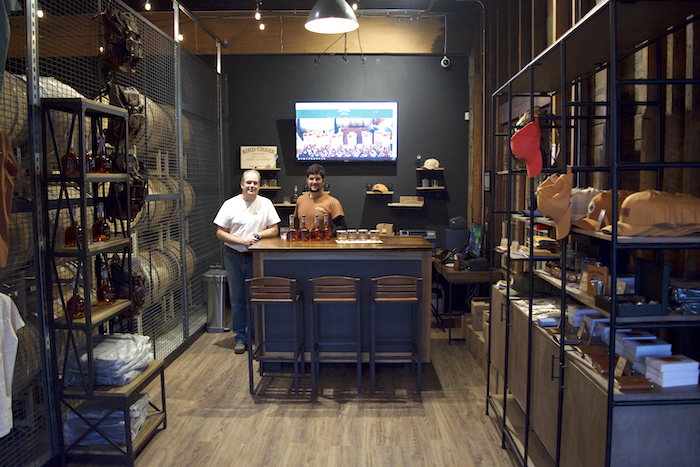
TWW: When you think about these rarer barley types you’re choosing, how are you picking them? It’s not like the farmer’s likely got a flask of whiskey made from it sitting around to sample from. What determines for you what the taste profile will be and what grains you go with?
Stell: The good thing is that we’re not the first. Obviously people have been doing this for a while. I had a trip this summer to Scotland and I brought a couple bottles with me, real kind of ego thing to do I guess, but some friends that work in a couple of Scottish distilleries asked me to bring some whiskey. And I said, “Can we try this? I just want to share it with you. Let me know what you think.”
And I asked them, [including] this master distiller [that] had a couple of distilleries, “What did you used to use? You used to know the varieties. You don’t market them at all anymore. You rarely do. It’s more about barrels and how you age it and how long you age it.”
The legacy is they have 300 years of making whiskey. That’s what their competitive advantage is. Almost all of them said, “We used to use these amazing varietals back in the thirties, forties and fifties, even sixties. But everything since then has gone to production. Most people are impacted by finance. And finance says use a less expensive barley that produces more alcohol – you’ll make more money.”
That doesn’t mean quality – it never means quality in any business whatsoever.
[For us, for example,] there’s a farmer that’s been selling his barleys to a bunch of brewers in Washington state and a few distilleries. His comment to me was, “What we discovered was that our cows like our barley because it tastes better.” That’s like a perfect example of somebody that says, “We knew it tasted better,” but it was not a great producer or yield buy so we just couldn’t get the value in, so we reduced the amount we were selling until somebody came and said, ‘I want to make beer with it,'” not too long ago. They basically said, “Well, why is that?” “Well, we know it tastes better so let us make some beer.” And obviously from there he started marketing it as a great way to make beer and whiskey .
To me that’s the perfect in-road into talking to a farmer, and that happens whether it’s in coffee or corn or you name it. It’s a variety that’s been around. And this particular one had been an old German variety of Baronesse. They’re become very popular with breweries. They’re not cheap. They’re probably five times the cost of a normal barley. What we found is that it’s one of those old varieties that we think holds up on its own.
We just launched that one, the single varietal [of Baronesse]. It’s going to sell out pretty quickly.
The way we’re finding the barleys is usually going through the malting houses and asking them, “What kind of heritage varieties do you have, of what volume? Where are they located? Can we talk to the farmer?” And then we go from there, from the farmer.
Once we interview the farmer, we say, “Can we come out and see you? We want to know about the history of the barley. Is it interesting? Does it have a good history? Is it really rare? Is it just unique to this area? We want to know about it.”
We’re not sure what [will] scale, but we’ll probably release all the barleys independently. If it’s not the greatest individually, we’ll end up using it to blend with another whiskey that can enhance it. That’s how we’re going to take the approach to this.
TWW: Production’s not going on site here. What can you say about where the production’s being done and who’s helping out with it?
Stell: When we first started out, Stone Barn Brandyworks here in Portland helped us do all of our test batches. They took the bull by the horns, showed me what we want to do and did a couple test barrels.
Then they also helped me find Loch & Union out of American Canyon, California. They have quite a bit bigger distillery – our goal was to start with a barrel or two of each and then just quickly jump to 32 barrels. We went down to see them after the first year. They’re really properly set up for what we’re looking for [in] single malts.
We use part of their production – it lasts about a month and a half right now for their production facility. We do all of our production at once. For the first two years we aged with them and now…we’re hoping we can start all our aging here. We’ve aged in Portland a little bit [already] the barrels that were here.
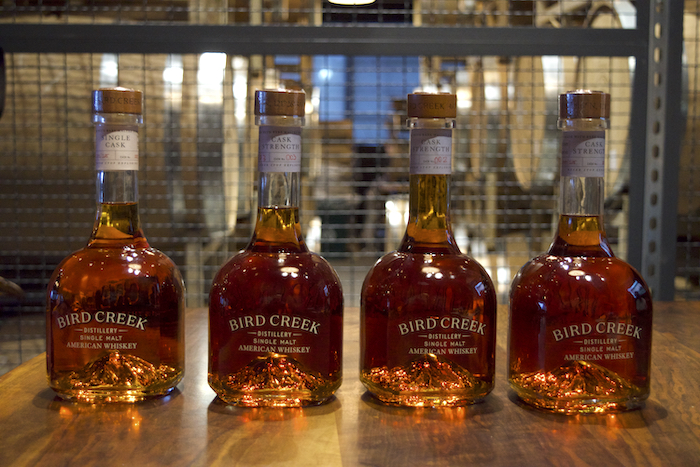
TWW: Out the gate, your products are available just in Oregon?
Stell: Oregon only right now.
TWW: And what are you launching with?
Stell: We launched with our barrel number five, which is the only barrel in everything we’ve so far barreled where we’ve blended two varieties and aged them in one barrel. We bottled that at barrel strength and we bottled it [also] at 45%. The second barrel is a full barrel of Baronesse single varietal. It is all 100% barrel strength at 57.5%.
And then the next barrel we’re launching will be a Full Pint varietal that Oregon State developed that is grown in Madras. That’ll almost be five years in the barrel and that’ll be barrel strength as well.
TWW: Great, thank you for your time.








